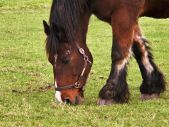Effects of fusariotoxins in horses

The Department of Veterinary Sciences and Technologies for Food Safety from the University in Milan, Italy looked at the effects of fusariotoxins in horses.
Fumonisins, trichothecenes and zearalenone are the most commonly occurring Fusarium mycotoxins in cereal grains and animal feed. The researchers looked at the toxicity of these mycotoxins in horses with particular reference to recent data on specific and proposed syndromes.
Compared to other animal species, very little information is available on the adverse effects of fusariotoxins in horses. Fumonisin B(1) (FB(1)) is the causative agent of leukoencephalomalacia, which is typified by depression, aimless circling, head pressing, paresis, ataxia, blindness and death. FB(1) has also been shown to cause liver damage and cardiovascular dysfunction. Exposure to deoxynivalenol in conjunction with other fusariotoxins seems to be associated with reduction of feed intake and decrease in bodyweight, whilst the T-2 Fusarium mycotoxin may typically induce oral lesions and zearalenone has been implicated in reproductive disorders.
However, still many questions remain on the synergic effects of fusariotoxins and on a possible relationship between mycotoxins and equine colic and more studies in this field are needed according to the researchers.
The full research was published in the Veterinary Journal (2009)











